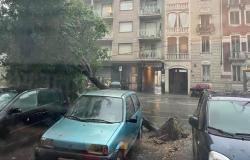The Mose is precious, but it is not forever. And if Venice is considered a universal heritage of inestimable value, it is good to start thinking about solutions for the future: that is, when the sea level rises to such an extent as to render the current system of mobile dams that protect the city from the water. As already noted by Ursula von der Leyen, President of the European Commission, ”Venice is a clear example of how the intensity and frequency of extreme phenomena are increasing, the symptom of a tragedy that today is only just beginning. In the long term the only solution is to fight climate change, only in this way can we fight high tide.”
First of all, a fixed point. As clarified by a recent study published by Ca’ Foscari University (Boon and burden: economic performance and future perspectives of the Venice flood protection system), in any possible future scenario the benefits guaranteed by the MOSE are enormously higher than the costs of the investment and other economic losses, such as those suffered by the port. In essence, without a protection system, flooding would devastate the city, and would do so more and more often as the years went by, creating incalculable damage.
The increase in closures
However, the increase in closures poses challenges to the medium- and long-term sustainability of the infrastructure, which essentially risks becoming unusable well before the end of the century. According to the research, if the MOSE is activated with tidal forecasts of 110 centimeters at mid-sea, 50 consecutive days of closure of the lagoon could be exceeded in the last quarter of a century. At that point, even if the infrastructure was technically capable of supporting such a workload, such intense use would still become too expensive and have too much of an impact on the environment. Ultimately, the MOSE could be excessively stressed between 2060 (in the worst climate scenario) and 2070 (in the best one, i.e. in the hypothesis of effective containment of climate change).
There is no precise “expiration date”, but the risk is that it is significantly closer than that hypothesized by those who designed the Mose (the official website states that the work can protect Venice and the lagoon from tides as high as to 3 meters and a rise in sea level of up to 60 centimeters over the next 100 years). ”A lot depends on how much we manage to combat climate change,” explains Carlo Giupponi, full professor of environmental economics at Ca’ Foscari University and coordinator of the aforementioned study. The gap, in fact, is quite wide: ”If we are good the sea could rise by 20-30 centimeters at the end of the century”, while in the most pessimistic hypothesis it could rise by even 70 centimetres. Added to this is the phenomenon of subsidence, or the gradual sinking of the city, which is currently quantified at 3-4 millimeters per year.
After the MOSE
These are long-term scenarios, but if we consider that it took 50 years to get to the realization of the MOSE, it is time to move. “In another 40-50 years we will have to have created what is combined with the MOSE or replaces it – warns Giupponi – and it is necessary to define and experiment now with new strategies to deal with the rise in sea levels, when the work does not will be more sufficient.” The study proposes some general solutions in this sense: on the one hand, work further on raising the city’s banks, to avoid flooding with tides of up to 130 centimetres; on the other, pumping sea water underground, hundreds of meters deep, to counteract subsidence and raise the city.
And then there are the “extreme remedies”: clearly separating the sea and the lagoon, similar to what happens in Holland, with protective dams. A strategy that would lead to an upheaval of the lagoon system, which in turn should be counteracted: “We can imagine a lagoon that becomes a technological system of locks, pumps and dams – hypothesizes Giupponi – with bypasses that allow the entry of sea water to maintain the salinity and diversion of some rivers”. In addition to this, of course the move of the port to the open sea: an offshore terminal which, moreover, is already in the Port Authority’s plans.
European elections: dates, candidates and programmes
The lagoon system
As regards the impact of the MOSE on the lagoon ecosystem, the debate is ongoing. It is a system that has been in operation for a relatively short time and there are no solid studies on it yet, but it is clear that the effect of the lifts will be more evident as their frequency increases. When the dams come into operation, the flow between the lagoon and the sea is interrupted, and this has consequences: just think that the Venice sewage system is partly based on a water exchange mechanism, with the wastewater being carried away by the currents. .
The longer the lagoon remains closed, the greater the risk that the ecosystem will be affected through greater development of macro algae, resulting in a lack of oxygen and the death of fish. From this point of view, it should however be remembered that the Mose is not “just Mose”: the general plan of interventions includes many other works, including those dedicated to the protection and reconstruction of lagoon habitats. So far, for example, 1,600 hectares of new mudflats and salt marshes have been created and 200 kilometers of canals recalibrated. “We also evaluate compensatory works in economic terms – says Giupponi – for example, salt marshes and seagrass meadows perform important services in terms of carbon sequestration, and in this they are even more efficient than a forest”.
What the landscape will be like
Recent research by the Institute of Geosciences and Georesources of the Cnr of Padua reiterates that the morphology of the lagoon is threatened, in fact, by the rising sea and the simultaneous lowering of the land. “We predict – explains Luigi Tosi, research director of the Cnr-Igg – that by 2050 the lagoon morphologies, currently located between 25 and 50 cm above sea level, will be reduced by 16 square km, and those between 0 and 25 cm of 18 square km. This loss of morphological heterogeneity will have a negative impact on the precious ecological benefits that the lagoon environment provides”. The Mose’s mobile barriers have a negative impact because they “reduce the supply of sediment to emerged areas such as salt marshes: without new sediments, these areas will not be able to grow in height and risk disappearing”. Among the most obvious risks, confirms researcher Cristina Da Lio, “there are the loss of the important Co2 absorption mechanism, the threat to the life cycles of lagoon species and the danger of an overload of nutrients harmful to the balance of the ecosystem”.
However, we can look to the future with confidence: Venice has such international importance that it will probably be able to count on the investments necessary to find solutions. “We share the results obtained with our study – concludes Giupponi – in the hope of stimulating reflection on the part of those with decision-making power”.






